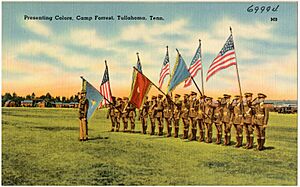Camp Forrest facts for kids
Camp Forrest was a very large training base for the U.S. Army during World War II. It was located in a wooded area east of Tullahoma, Tennessee. The camp was active from 1941 to 1946. It was named after Civil War General Nathan Bedford Forrest.
Contents
History of Camp Forrest
From Camp Peay to Camp Forrest
The area was first built in 1926 by the Tennessee Army National Guard. It was about 1,040 acres big. This first camp was called Camp Peay. It was named after the Tennessee Governor at the time, Austin Peay.
In 1940, the U.S. Army took over Camp Peay. They made it much bigger, expanding it to 85,000 acres. In 1941, the camp's name was changed. The Army Chief of Staff, General George C. Marshall, decided this. He said the Army did not usually name federal bases after local politicians. Especially if they did not have a strong military background.
The state of Tennessee suggested the name Nathan Bedford Forrest. He was a Tennessean who had been a general in the Confederate Army. Even though some people did not like this name, the Army approved it. An African American newspaper, The Chicago Defender, strongly disagreed with the name. The Illinois state government even tried to get it changed. This happened when their National Guard division trained there.
What Soldiers Did at Camp Forrest
Camp Forrest was a busy place. Soldiers trained there for many different jobs. These included infantry (foot soldiers), artillery (big guns), engineers, and signal (communication) teams. Cooks also trained there.
The camp also had a large hospital. It was a temporary home for troops during big training exercises. Famous General George Patton even brought his 2nd Armored Division here for training.
There was also an air training base called William Northern Field. The Army Air Forces used it. They trained crews to fly large, four-engine B-24 bombers.
Life at the Camp
Soldiers at Camp Forrest had many things they needed. There were clubs, guest houses, and a library. They also had stores, a post office, and a hospital. There was a chapel, a theater, and barracks for sleeping.
The Red Cross and Army Emergency Relief also had facilities there. For fun, soldiers could go swimming or play archery and tennis. There was a sports arena and a nine-hole golf course.
Prisoners of War and Internees
Camp Forrest became a prisoner-of-war camp on May 12, 1942. It held prisoners from Italy and Germany. These prisoners worked at the camp's hospitals. They also worked on local farms.
The camp also held some civilians. These were Japanese, German, and Italian-Americans. They were arrested when the war started. This was part of a program called "Alien Enemy Control." Many of these people were held without a proper trial. Over 25,000 "alien enemies" were held in different places in the U.S. during the war. Camp Forrest held over 700 of them. About 200 of these were of Japanese background.
In 1943, these civilians were moved to other camps. This made room for actual prisoners of war captured in battle.
In 1945, the U.S. government started a program for German prisoners. It was called the Intellectual Diversion Program. Its goal was to teach Germans about the American way of life. They used education and fun activities to try and change the prisoners' ideas. The government said this program was successful for many prisoners.
Camp Forrest's Impact on Tullahoma
Building Camp Peay and then Camp Forrest changed Tullahoma a lot. The government took land from many families. These families had owned and worked their land for many years. Often, they received little or no money for their land.
Life for civilians in Tullahoma changed. Roads were sometimes blocked. There were traffic jams and crowded stores. Mail delivery could be difficult. People had to drive at night without lights sometimes. Soldiers camped on lawns and fields. Many crops and fences were damaged. Owners usually did not get paid for these damages.
In 1940, Tullahoma had about 4,500 people. By the end of the war, it had grown to 75,000 people. Many military people stayed in the area after the war. This big increase in people made everything more expensive. Property values, taxes, and everyday items all cost a lot more.
After the War
In 1946, World War II ended. Camp Forrest and Northern Field were no longer needed. The buildings were sold at auction. They were taken apart and moved away. Water, sewer, and electrical systems were sold for parts. Only roads, brick chimneys, and concrete foundations were left.
The camp's Sports Arena was bought by Lincoln Memorial University. It was moved to Harrogate, Tennessee. There, it was renamed the Mary E. Mars Gymnasium. This building is still used today by the school's sports teams and classes.
After the camp closed, the land was not given back to the original owners. Instead, the Air Force used it to build a new center. In 1951, President Harry Truman opened this new center. It was named the Arnold Engineering Development Center. This honored General Henry H. Arnold, a World War II commander. He was the only Air Force officer to reach the highest rank of 5-star general.


